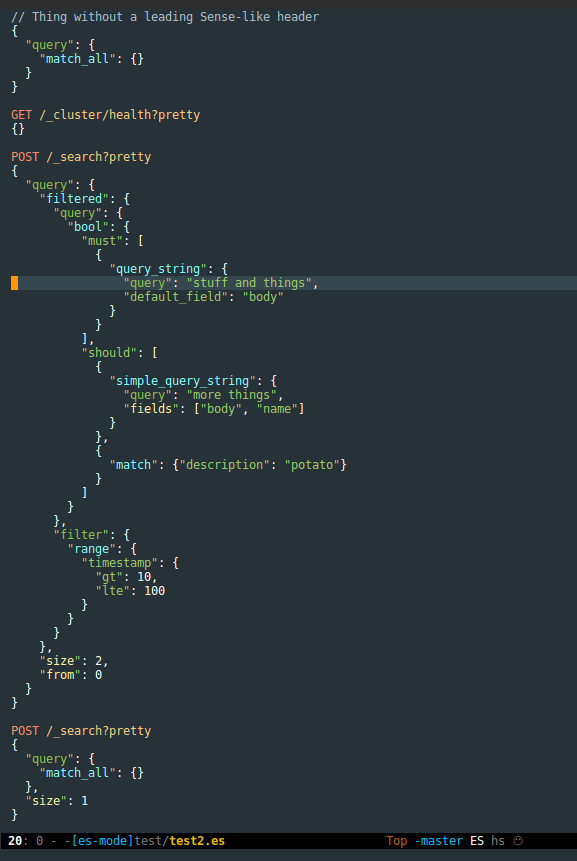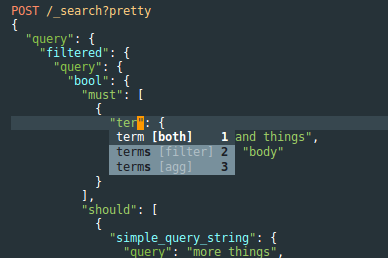https://github.com/dakrone/es-mode
An Emacs major mode for interacting with Elasticsearch
https://github.com/dakrone/es-mode
elasticsearch emacs
Last synced: 23 days ago
JSON representation
An Emacs major mode for interacting with Elasticsearch
- Host: GitHub
- URL: https://github.com/dakrone/es-mode
- Owner: dakrone
- License: gpl-3.0
- Created: 2014-01-31T15:20:39.000Z (over 11 years ago)
- Default Branch: master
- Last Pushed: 2022-10-26T11:04:39.000Z (over 2 years ago)
- Last Synced: 2025-03-31T17:55:12.566Z (2 months ago)
- Topics: elasticsearch, emacs
- Language: Emacs Lisp
- Homepage:
- Size: 319 KB
- Stars: 197
- Watchers: 10
- Forks: 34
- Open Issues: 15
-
Metadata Files:
- Readme: README.md
- License: LICENSE
Awesome Lists containing this project
- awesome-elasticsearch - ES-mode
- elasticsearch-collection - ES-mode
README
## Elasticsearch mode for Emacs
Provides a major mode for editing ES query examples. Better highlighting and
indention than sh-mode or js-mode.
It is intended to be a mixture of the three modes as well as mimicing some of
the highlighting from Kibana's Dev Tools Console.
You can also think of it as
[Kibana's Console](https://www.elastic.co/guide/en/kibana/current/console-kibana.html)-envy
for Emacs users.
### Installation
`es-mode` is available in the MELPA repository. Do this, if MELPA isn't already in
your sources:
```elisp
(require 'package)
(add-to-list 'package-archives
'("MELPA" . "https://melpa.org/packages/" ))
```
Then run `M-x package-refresh-contents` to load the contents of the new
repository, and `M-x package-install RET es-mode RET` to install `es-mode`.
### Usage
```elisp
(add-to-list 'load-path "/path/to/es-mode-dir")
(autoload 'es-mode "es-mode.el"
"Major mode for editing Elasticsearch queries" t)
(add-to-list 'auto-mode-alist '("\\.es$" . es-mode))
```
You can now open a file with an `.es` extension and `es-mode` will
automatically load..
#### Keyboard Shortcuts
| Key | Action | Description |
|-----|--------|-------------|
| `C-c C-c` | es-execute-request-dwim | Execute the request you're currently on |
| `C-c C-p` | es-goto-previous-request | Go to the previous request |
| `C-c C-n` | es-goto-next-request | Go to the next request |
| `C-c M-w` | es-copy-as | Copy the request as a `curl` request |
| `C-c C-u` | es-set-endpoint-url | Set the ES endpoint requests will be executed against |
| `C-c RET` | es-set-request-method | Set the rest method type (only for non-prefixed requests) |
| `C-c s` | (requires `yasnippet`) | Insert a snippet for searching |
| `C-c i` | (requires `yasnippet`) | Insert a snippet for new index creation |
### Features
- Highlighting for builtin queries, facets, aggregations, special paramaters
- A [company-mode](http://company-mode.github.io/) backend for completing ES
queries
- Better indenting than sh-mode (indents like js-mode)
- Sending the queries as a http-request to Elasticsearch endpoints.
- Navigate via goto-(next|previous)-request with `C-c C-n` and `C-c C-p` (when
using parameters)
- An Elasticsearch Command Center mode for monitoring clusters
- Hooks for responses, see `es-response-success-functions` and
`es-response-failure-functions`
- Support for "es" mode blocks in org-mode
- Pass the resulting JSON through [jq](https://stedolan.github.io/jq/) to return
only the values you want in org-mode
- Displays warning headers from Elasticsearch in the results buffers for
deprecated features
- [Yasnippet](https://github.com/joaotavora/yasnippet) support with built-in
snippets for common operations
- Ability to copy a request as a [curl](https://curl.haxx.se/) request, or other
type of request (customizing `es-copy-as-fn`)
- Support for kibana-like triple quoting (`"""`) for request bodies
#### Using hide-show mode in results buffers
If you would like to enabled `hs-minor-mode` automatically on ES results
buffers, use the following:
```elisp
(add-hook 'es-result-mode-hook 'hs-minor-mode)
```
### Example
You can specify requests with two different formats:
#### With parameters
In the document, specify parameters similar to Console, like so:
```json
POST /myindex/_search?pretty
{
"query": {
"match_all": {}
}
}
```
Hitting `C-c C-c` anywhere on the parameter or body of the request will execute
the request, opening a response buffer. The base-url can be configured by
customizing the `es-default-url` var.
You also don't have to provide the leading "/", similar to Console (I personally
think the leading "/" looks better though), like this:
```json
POST myindex/_search?pretty
{
"query": {
"match_all": {}
}
}
```
If you do not want to specify `?pretty` every time, you can customize the
`es-always-pretty-print` var (defaults to `nil`).
#### Without parameters (deprecated)
Without any parameters, you can specify a request:
```json
{
"query": {
"match_all": {}
}
}
```
With the request region highlighted or inside the query structure, hit `C-c C-c`
to execute it. The first time you do this you will be prompted for the URL and
HTTP method. You can also set the URL with `C-c C-u` and the method with `C-c
C-m`.
This is deprecated in favor of the console-like syntax, as it increases
complexity for maintaining es-mode.
#### Self signed certificates
If your ES endpoint has TLS enabled with self signed certificates (this is insecure!) you'll need to make `curl` ignore those. There are two ways:
1. Specify `--insecure` in the Emacs variable `request-curl-options`.
2. Create a `~/.curlrc` containing `--insecure` (see [the curl man page](https://curl.haxx.se/docs/manpage.html)).
#### Screenshot
See `test.es`, `test2.es`, and `all.org`, here's a screenshot from my theme:

And here's an example of the completion of queries/filters:

### Org-babel support
One of the main reasons I started this was better highlighting and indention for
org-babel. So add the snippet below to your .emacs:
```
(org-babel-do-load-languages
'org-babel-load-languages
'((elasticsearch . t)))
```
And then you will be able to hit `C-c C-c` on code like this in your org-mode
file:
```
#+BEGIN_SRC es
POST /_search?pretty
{
"query": {
"match_all": {}
}
}
#+END_SRC
```
OR (without parameters):
```
#+BEGIN_SRC es :method POST :url localhost:9200/_search?pretty
{
"query": {
"match_all": {}
}
}
#+END_SRC
```
org-mode uses the arguments `:url` and `:method` to know where and how
to send a query. If they are not present org-mode will use
`es-default-url` and `es-default-request-method` instead.
Tangling these blocks will produce `.es`, if you specify the filename
with `:tangle foo.sh`, es-mode will instead create a curl request for the body
of the request.
#### Generating org-mode tables from aggregations
Es-mode supports rudimentary table creation from aggregations using the
`:tablify` header parameter. For example, consider the following aggregations:
```
#+BEGIN_SRC es :tablify prices :results raw table
POST /test/doc/_search
{
"aggs" : {
"prices" : {
"histogram" : {
"field" : "price",
"interval" : 20,
"min_doc_count": 0
}
}
},
"size": 0
}
#+END_SRC
#+RESULTS:
| key | document count |
|-----+----------------|
| 0 | 4 |
| 20 | 0 |
| 40 | 1 |
| 60 | 2 |
| 80 | 2 |
| 100 | 1 |
| 120 | 0 |
| 140 | 0 |
| 160 | 2 |
```
Note that the "tablify" argument must be the name of the aggregation to be
tablified, in this example, "prices" is the name of the argument.
This also works for `terms` aggregations:
```
#+BEGIN_SRC es :tablify my_terms_agg :results raw table
POST /test/doc/_search
{
"aggs" : {
"my_terms_agg" : {
"terms" : {
"field" : "type"
}
}
},
"size": 0
}
#+END_SRC
#+RESULTS:
| key | document count |
|----------+----------------|
| eggplant | 5 |
| foo | 4 |
| widget | 2 |
| cog | 1 |
```
If you are using org-mode 8.3.1 or later, you can generate pretty ASCII graphs
from org-mode using
[orgtbl-ascii-plot](http://orgmode.org/worg/org-contrib/orgtbl-ascii-plot.html)
like so (hit `C-c C-c` on the `TBLFM` line to generate the graph):
```
#+RESULTS:
| key | document count | |
|-----+----------------+------------|
| 0 | 4 | WWWWWWWWWl |
| 20 | 0 | |
| 40 | 1 | WWc |
| 60 | 2 | WWWWV |
| 80 | 2 | WWWWV |
| 100 | 1 | WWc |
| 120 | 0 | |
| 140 | 0 | |
| 160 | 2 | WWWWV |
#+TBLFM: $3='(orgtbl-ascii-draw $2 0 5)
Or:
#+RESULTS:
| key | document count | |
|----------+----------------+--------------|
| eggplant | 5 | WWWWWWWWWWWW |
| foo | 4 | WWWWWWWWWl |
| widget | 2 | WWWWV |
| cog | 1 | WWc |
#+TBLFM: $3='(orgtbl-ascii-draw $2 0 5)
```
Be sure to pass the correct minimum and maximum values for the table (in this
example, 0 and 5) to the `orgtbl-ascii-draw` method.
#### Passing JSON through [jq](https://stedolan.github.io/jq/)
In org-mode you can also reduce the size of results by passing them through the
jq command-line tool. For example, compare the output of these two different org
blocks:
```
#+BEGIN_SRC es
GET /
{}
#+END_SRC
#+RESULTS:
#+begin_example
{
"status" : 200,
"name" : "Everyman",
"version" : {
"number" : "1.3.2",
"build_hash" : "dee175dbe2f254f3f26992f5d7591939aaefd12f",
"build_timestamp" : "2014-08-13T14:29:30Z",
"build_snapshot" : false,
"lucene_version" : "4.9"
},
"tagline" : "You Know, for Search"
}
#+end_example
```
And the same thing, but passed through the `jq` tool, extracting the "name" and
"version.number" fields:
```
#+BEGIN_SRC es :jq .name, .version.number
GET /
{}
#+END_SRC
#+RESULTS:
: "Everyman"
: "1.3.2"
```
You can use this to return only a certain hit, or the score of a hit, etc,
easily, so you can format the output as desired. See the
[full jq manual](https://stedolan.github.io/jq/manual/) for how to use jq.
es-mode uses `jq` in the `PATH`, however, if you want to specify an absolute
path you can customize the `es-jq-path` var as you like.
jq will only be run if the response is an HTTP 20[0-9].
#### Variable Substitution
`es-mode` includes support for variable substitution in org-babel
source blocks. The variable references in the body should be in the
form `${var-name}`.
```
#+BEGIN_SRC es :var index="theindex"
POST /${index}/_search?pretty
{
"query": {
"match_all": {}
}
}
#+END_SRC
```
Vars can also be used to use the results from other org-babel blocks.
In the example below, the first source block searches the index
`child-docs` for documents from the past month and `jq` is used to
select the `parent-ids` from the hits that are returned.
The second source block takes the `parent-ids` and binds it to the
variable `ids` in the header of the source block (`:var
ids=parent-ids`). When the code is run `${ids}` is replaced with the
JSON array prior to executing the search request against the
`parent-docs` index.
```
#+NAME: parent-ids
#+BEGIN_SRC es :jq "[.hits.hits[]._source.\"parent-id\"]"
GET /child-docs/_search?pretty
{
"query": {
{"range": {"time": {"gte": "now-1M/d"}}}
},
"_source": "parent-id"
}
#+END_SRC
#+RESULTS: parent-ids
#+begin_example
[
"id1",
"id2",
"id3"
]
#+end_example
#+BEGIN_SRC es :var ids=parent-ids
GET /parent-docs/_search?pretty
{
"query": {
{"ids": {"values": ${ids}}}
}
}
#+END_SRC
#+RESULTS:
#+begin_example
{
"took" : 227,
"timed_out" : false,
"_shards" : {
"total" : 4,
"successful" : 4,
"failed" : 0
},
"hits" : {
"total" : 3,
"max_score" : 5.3673162,
"hits" : [
{
"_index" : "parent-docs",
"_type" : "t",
"_id" : "id1",
"_score" : 5.3673162,
"_source" : {
...
}
},
{
"_index" : "parent-docs",
"_type" : "t",
"_id" : "id2",
"_score" : 5.3673162,
"_source" : {
...
}
},
{
"_index" : "parent-docs",
"_type" : "t",
"_id" : "id3",
"_score" : 5.3673162,
"_source" : {
...
}
}
]
}
}
#+end_example
```
### Elasticsearch Command Center
`es-mode` includes a mode called the "Elasticsearch Command Center", which is
meant for monitoring your cluster. This provides a graphical representation of
what's happening in the cluster.
To invoke it, simply do `M-x es-command-center`. ES-CC will automatically
refresh at `es-cc-refresh-interval` seconds, check out `M-x customize-group
es-cc` to see all of the customization options.
Here's a screenshot of what it looks like:

### Feedback
This is my first major mode for Emacs, feedback is welcome, especially pull
requests that show me what I'm doing wrong.